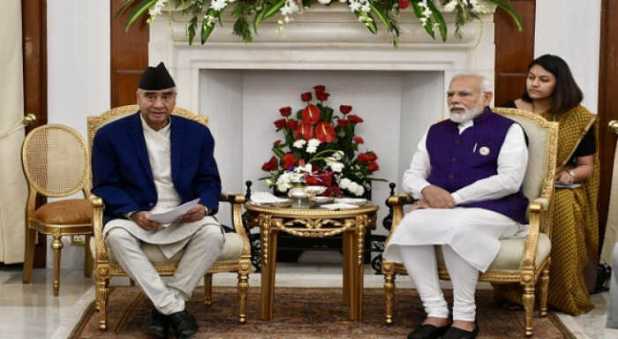
New Delhi, April 2 : Nepalese Prime Minister Sher Bahadur Deuba on Saturday raised the boundary dispute issue between India and Nepal during his talks with Prime Minister Narendra Modi and expressed hope that the issue would be resolved through the bilateral mechanism. In his media statement following delegation-level talks, Nepalese PM Deuba said: “We discussed the border issues. And, I urged Modi ji to resolve the issue through a bilateral mechanism.” India and Nepal share an approximately 1,800 km international open border, which is managed under the bilateral Treaty of Peace and Friendship (1950). To resolve boundary disputes, Nepal and India formed a Joint Technical Committee (JTC) in 1981, which was successful in resolving 97 percent of the border issues. The remaining three percent, approximately 606 sq km of disputed area, are the focus of the protracted border dispute. The dispute arose when in August 2019 India published a map that showed ‘Kalapani’ region in the Greater Himalayas as within India’s borders. The map portrayed the area as part of the Pithoragarh district in the state of Uttarakhand. Nepal immediately issued an objection to the map, as it identifies the region as an unsettled territory of the Darchula district in the country’s Sudurpashchim province. The border tension re-surfaced when on May 8, 2020 Defense Minister Rajnath Singh inaugurated an 80 km -long road to Mansarovar in Lipulekh area. In response to Nepal’s protests India said the road is built “completely within the territory” of India. The Nepal government then on May 20, 2020 unveiled a new map incorporating Kalapani, Limpiyadhura and Lipulekh within the Nepali territory. The new map was endorsed by the Nepal Parliament unanimously through a constitutional amendment. In response, India termed the move as “cartographic assertions.” The boundary row vis-a-vis Lipulekh resurfaced after Prime Minister Narendra Modi in December last year made a statement regarding road expansion via that region. In response to protests in Nepal, the Indian Embassy in Kathmandu issued a statement saying that “The government of India’s position on the India-Nepal boundary is well known, consistent and unambiguous. It has been comm cated to the government of Nepal. It is our view that the established inter-governmental mechanisms and channels are most appropriate for comm cation and dialogue. Mutually agreed boundary issues that are outstanding can always be addressed in the spirit of our close and friendly bilateral relations.” Asked about the Nepal PM’s statement, Foreign Secretary Harsh Vardhan Shringla said today that the issue was “discussed briefly” during the meeting between the two PMs. “There was a general understanding that both sides needed to address this in a responsible manner through discussion and dialogue in the spirit of our close and friendly relations and that politicisation of such issues need to be avoided.” He added that “Between any two neighbours there are a number of issues that are always outstanding. What is important between two close and friendly neighbours is that you have the ability to sit down discuss and sort out the issues in a manner that is satisfactory to both sides and that takes into account the facts of the matter and everything that goes with those issues” He said that India has sorted out its land and maritime boundary issues with Bangladesh amicably. “With Nepal also we have several mechanisms that discuss issues between both our countries and we will certainly; what we are saying is the two sides have had a brief discussion and generally felt that to start addressing this issue we need to have dialogue and discussion in a responsible manner. “And we’ve no doubt that between two close and friendly countries we will find the way to surmount these issues,” the Foreign Secretary said. RN

